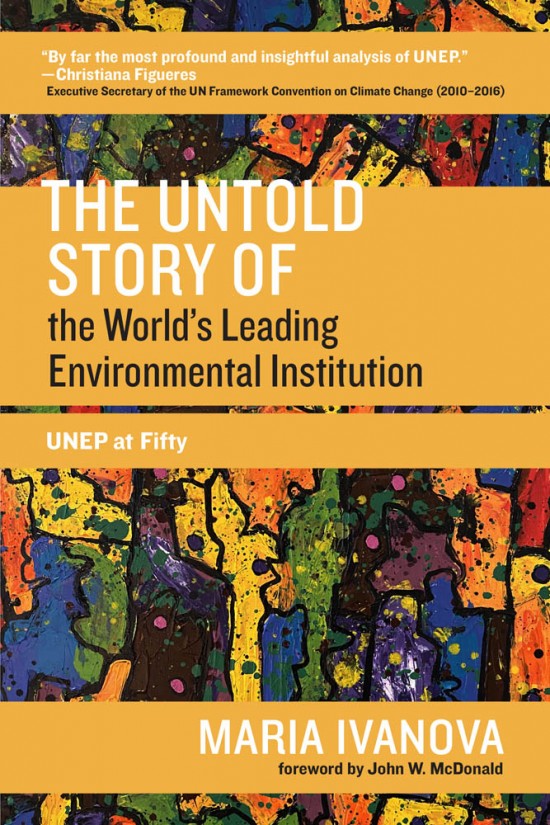United Nations Environment Programme – 50th Anniversary
Anniversaries occasionally offer opportunities to reflect deeply on the past and imagine a better future. By Udo E. Simonis
Fifty years ago, in 1972, a globally important environmental event happened: the „United Nations Environment Programme“ (UNEP) was established. And now, in 2022, the first full-length book on the world’s leading environmental institution can be read (Ivanova 2022).
The book builds on the efforts of very many people who created international instituitions, and often labored hard to ensure that they function well. The author met most of the founders, the leaders, and the operatives of the global environmental governance system – and so she wants to offer the full story, especially the untold story of their legacy.
Consequently, the „cast of characters“ presents thirty-nine people with strong insights about UNEP and the system of global environmental governance. It starts with Inger Andersen, the Under-Secretary-General of the UN and current Executive Director of UNEP, leads to Kofi Annan and Ban Ki-Moon, the Secretary-Generals of the UN, to Elisabeth Dowdeswell, the first female UNEP Director, to Christiana Figueres, the former Executice Secretary of the UN Climate Convention, to Wangari Maathai, the founder of the Green Belt Movement and Nobel Peace Prize winner, to Gus Speth, the founder of the World Resources Institute and Administrator of the UN Development Programme (UNDP), to Mostafa Tolba, the longest-serving UNEP-Director, and to Achim Steiner and Klaus Töpfer, the two German Executive Directors of UNEP, to name just a few.
„UNEP at Fifty“ is a biography that explains its origin and formative years, elucidates its successes, crises and turning points, and presents an outlook for its possible future. In so doing, the author wants to record previously untold stories, to correct misunderstandings and to reveal the life within what is often considered a „lifeless bureaucracy“; no doubt, she is a good old friend of UNEP. So, criticism is modest, and future demands can not be expected to be radical.
Creating UNEP was the most visible and enduring outcome of the first global environmental summit, the 1972 Stockholm Conference on the Human Environment. The outcome was often called a „small, smart, and nimble“ anchor institution for the global environment, with headquarters in far-away Nairobi, Kenya. Its raison d’etre was defined as coordination of environmental activities in the UN system; further it was expected to produce scientific assessments of the state of the global environment, and to provide technical and policy analysis. UNEP was to be a normative body, not an operational or service organization conducting specific environmental activities on its own.
UNEP has modestly grown in the five decades from a small unit in Nairobi to an organization of about 1,200 staff, most of them however with only a very few employees. UNEP’s financial resources have been and still are very limited; they comprise the regular UN budget allocations, and voluntary contributions and earmarked contributions from UN member states. Although its overall income had grown to $ 570 million in 2018, some 87 percent of it came from extrabudgetary resources that respond primarily to donor preferences – and so heavily limit the organization’s initiatives.
For many years after the Stockholm conference the major constitutional conditions of the institution and its insufficient funding had lead to occasionally heavy debates: Is UNEP weak and insufficient or has it been an outstanding success? Much of the global environmental governance literature assumes that UNEP was purposefully designed to be weak, that industry and governments saddled UNEP with its form, function and financing in order to incaptivate it. After 50 years of existence, this assumption could be called irrelevant. Very relevant however is the question of how to make UNEP effective for the future.
From the very beginning, UNEP was accompanied by discussions on necessary reform. The potential reforms could be marginal or fundamental, and it is interesting to see what came into the focus. Kofi Annan, the seventh UN General-Secretary in 2002 published a remarkable book, three German scholars came out with specified books: Andreas Rechkemmer with a book on an „Environment and Development Organization“ (UNEO), Frank Biermann and Steffen Bauer with a book on „A World Environment Organization“ (WEO). A strong push in this direction also came from the conference „Citizens of the Earth“ in Paris, 2007. Point 2 of its resolution stated: „In Rio, Johannesburg, Montreal and Kyoto, the international community has moved forward. But we need to go further…“ In point 7 then came the demanding conclusion: „We call for the transformation of UNEP into a fully-fledged international organization that is genuinely universal. Modelled on the World Health Organization (WHO), the new United Nations Environment Organization (UNEO) could be a strong voice with global recognition“.
This „Paris Call for Action“ was well heard but not implemented. So, the dispute on the best institutional solution is still on. Here, three different model-types compete with one another: The first model is to revalue the subsidiary organ UNEP into a spezialized agency – along the line of the WHO (World Health Organization) or the ILO (International Labour Organization). The second model goes much further. As we now have more than 500 international environmental agreements, and a considerable number of UN Environmetal Conventions, it is suggested to integrate all this into one comprehensive „Global Environment Organization“ (GEO) – preferably along the line of the World Trade Organization (WTO). The third model proposed is a hierarchical international organization, based on the principle of majority decision-making, and the enforcement over nation states who do not agree to the decisions made.
At present it is not at all clear which of these models will carry the day.
Over the years, UNEP produced and supported numerous high-quality reports that articulated the science and urged for a strict policy response. The reports on chemical pollution set the standard for environmental health criteria for very many chemicals. The first integrated environment assessment, the „Global Environment Outlook“ (GEO) published in 1997, became the flagship publication on the environment, being released every five years, and now having reached its sixth edition. In the field of climate change, UNEP’s reports and its collaboration with the World Meterological Organization (WMO) set the stage for the Intergovernmental Panel on Climate Change (IPCC) and the UN Framework Convention on Climate Change (UNFCCC). However, both these important institutions were not located at the UNEP headquarters in Nairobi, but in Geneva and in Bonn.
One can mourn about many other developments in the history of UNEP. A very serious one is, that the need for assistance to environmental activities at the local level remained largely unfulfilled – and vice versa: UNEP did not intensively and regularly ask local communities around the world what they see as being important and momentous. A concrete procedure could help to get out of thís pitfall: UNEP should learn from UNICEF.
These two institutions are very different but both are addressing global problems, the one the safety of the environment, the other the safety of children. In doing so, UNICEF is a global and a local institution at the same time. It is present in more than 190 countries of the world, with annual expenditures of more than 5,4 billion US dollars. (In Germany, for instance, UNICEF has more than 200 local groups, is permanently supported by more than 8.000 honorary members, and spends annual expenditures of more than 120 million Euro).
UNEP seems to have no such local groups and honorary members, and is broadly known only by academicians, journalists and government officials. And that could mean: UNEP, the „anchor institution for the global environment“ in actual fact has no effective anchorage on the local level, the level where most of the effects of global problems are felt first. It would be more pleasant to look at UNEP’s seven major fields of activity, on Ozone Depletion, Marine Pollution, Desertification, Chemicals and Hazardous Waste, Climate Change, Biodiversty, and Forests – but here a few comments must suffice.
A major success in global environmental governance was the reversal of the depletion of the ozone layer in the train of the Montreal Protocol. Work on marine ecosystems was among the first of UNEP’s topic initiatives, starting in 1974 with the „Regional Seas Programme“ which included fourteen regions and more than 140 nation states. On desertification, UNEP invested considerable resources in research and assessment, but it took until 1994 to sign the UN Convention to Combat Desertification, ending with a curious locatioal decision: The secretariat of this convention was located in Geneva, and in 1999 moved to Bonn – cities in two countries where so far no desertification emerged.
Climate change had been on the international agenda already before the 1972 Stockholm conference. However, it took until 1979 that on basis of collaboration of UNEP and other organizations „a world conference of experts on climate and mankind“ – the first World Climate Conference – was convened in Geneva. The climate issue got high prominence after that, and many meetings took place. In December 2021, Glasgow convened the 26th conference of the parties to the UN Framework Convention on Climate Change (COP 26). UNEP’s key goal in this regime is the global transition to low carbon, resource-efficient, equitable, and sustainable development. Climate change is now an overarching global concern and has a strong convention secretariat in Bonn – not in Nairobi, and not in Geneva.
Over time, UNEP became also a major player in international biodiversity research and conservation. In 2019, its „Global Assessment Report“ on these topics stated that globally one million species are at risk of extinction. To be effective, the institutional landscape for biodiversity however is much too complex, with a dozon conventions and protocols. Therefore, in 1989, governments requested UNEP to develop a framework convention with the purpose of rationalizing existing activities. From the very beginning of the negotiations for such an integrated Convention on Biological Diversity (CBD), barriers were built, some from UN agencies, others from member states. Unlike with ozone and climate change, here a strong body of scientific evidence was still lacking, and old tensions between the North and the South came up again. Meanwhile a question is prominent: How serious the biodiversity crises must become before unified action will take place?
A similar melancolic mood comes up when looking at the global forests. Institutional develoment of global forest policy was a dramatic-play, not a success-story. At the 1992 Rio-Conference on Environment and Development (UNCED) it had been possible to agree on a climate, a biodiversity, and a desertification convention, but no consensus was reached on a forest convention. For the following three years, there was total silence on that isue. But then came a great mess, three temporary institutions following each other: starting with the Intergovernmental Panel on Forests (IPF),1995 -1997, the Intergovernmental Forum on Forests (IFF),1997-200, to the United Nations Forum on Forests (UNFF), 2001-2005. IPF and IFF presented a broad palette of suggestions on sustainable forest management, but didn’t find a consensus for an integrated global forest strategy. UNFF had a higher status, but didn’t reach a consensus on a convention with a triple goal system: protection of forests, sustainble use of forests, and global increase of global forest stock. This episode ended as UNFFinished business.
Some hope, however, spread around the world with the study of a group of scientists at ETH Zürich in 2019, on „The global tree restoration potential“. According to this computer-based assessment the current 2.8 billion hectares of global forests could easily and without major conflicts be extended to 4.4 billion hectares. So far, at the global level nothing in this direction has been started. By contrast, in October 2019, a poor African country succeded with a nation-wide effort to plant 354 million trees in just one day.
Will the 2022 anniversary of UNEP help to take up new opportunities? The „forest option“, no doubt, is highly significant for global climate policy. It is an essential part of „nature-based solutions“ (NBCs) for global environment problems, together with moors, croplands, grasslands, terrestrial and coastal wetlands, and urban greenary. Any major activity of UNEP on the issue of nature-based solutions for practical environment policy would be welcome.
Some conclusions: Anniversaries occasionally do produce new opportunities. In 2022, we celebrate the 50th anniversary of the „United Nations Environmemt Programme“ (UNEP). This institution has learned over time, but as it stands now, UNEP cannot, I fear, prevent further environmental decline of the global ecosystems, not to speak of their renaturation. The debate on necessary reform of UNEP has been quite intense, and radical proposals presented were many – but they were not implemented in strict consequence.

UNEP is still a subsidiary organ within the UN General Assembly, and not a more powerful spezialized agency, with sufficient staff and sufficient funds. UNEP still is a „far-distant institution“, not really reaching the local citizen. In view of the occuring negative ecological trends and the continuing global overshoot UNEP seems to have „fallen out of time“. Of course, almost anything that focuses intelligent attention on UNEP and the environment internationally is a positive. But should the „old times“ continue, sooner or later a drastic institutional revolution in global environmental governance may become inevitable.
This structural change could reach from turning the existing subsiduary organ „United Nations Environment Programme“ (UNEP) into a spezialized ageny, the „United Nations Environment Agency“ (UNEA), into an „Environment and Development Organization“ (UNEO), or into a „World Environment Organization“ (WEO). If none of these models will come into existence in time, the minimal future reform should at least consist of a stronger engagement regarding basic functions, effectivity and public standing of UNEP. Such a minor reform could easily be initiated by the United Nations Environment Assembly – or by the UN Secretary-General Antonio Guterres himself. It seems that the necessary ecological consciousness for an innovative initiative exists, as his provocative, historic address at the Columbia University testifies.
- Literature: Maria Ivanova “The Untold Story of the World‘s Leading Environmental Institution: UNEP at Fifty” | Foreword by John W. McDonald | The MIT Press 2022
Source
The author: Dr. Dr. h.c. Udo E. Simonis, Professor Emeritus of Environmental Policy at the Berlin Social Science Center (WZB).








